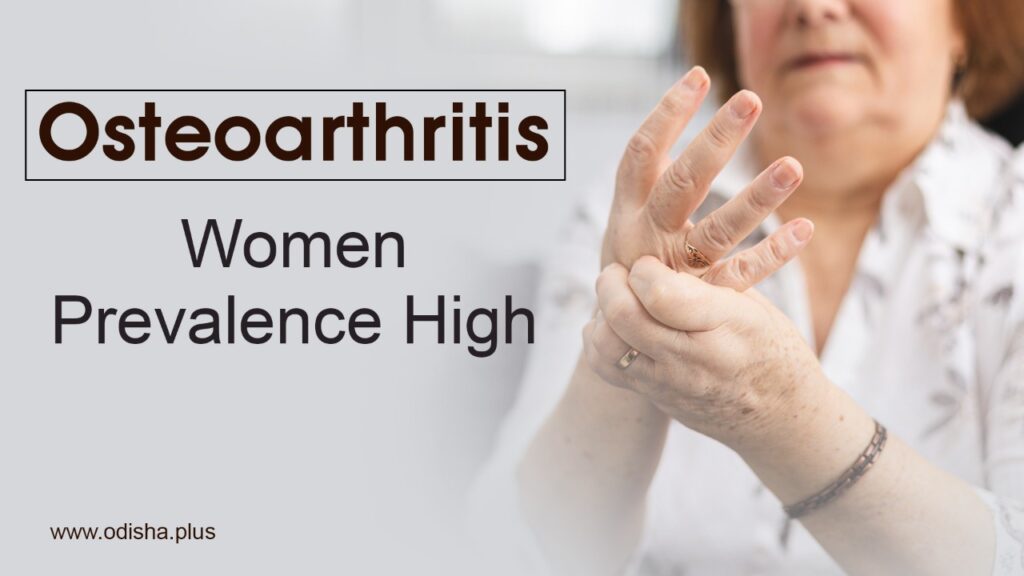Sanjeev Kumar Patro
Here is a health alert for women in Odisha. Post menopause women have been identified as highly prone to Osteoarthritis (OA).

The big worry here is this degenerative disease can render one immobile, as the musculo-skeletal disease has no treatment protocol, except physical exercises.
For which, the focal theme of this year’s World Physiotherapy Day has been ‘Managing Osteoarthritis’.
OA Enormity & Gender Divide
As per the Union Health Ministry Annual Health Survey 2020, the incidence of arthritis in women population is higher than males. The prevalence per lakh population shows number of women suffering from arthritis is twice that of males in Odisha. When the female prevalence has been around 335 per lakh, it’s around 245 per lakh in males. Moreover, the prevalence is higher in urban settings than rural.
District Wise Burden
A glance at the last Annual Health Survey gives a clear perspective on the prevalence of arthritis in the State. The burden of arthritis in Odisha has been highest in Jagatsinghpur, where the prevalence has been estimated at 1150 per lakh population.
Except for Kendrapada, the prevalence of arthritis is highest in coastal areas, vis-a-vis south, north and western Odisha. Almost all coastal districts have higher prevalence than the State average. (see the image below).
OA – RMRC Study
The ICMR’s Bhubaneswar arm – Regional Medical Research Centre- conducted a cross-sectional study in the rural block of Tigiria in Cuttack district between June 2019 and February 2020.
As per the study data, when 50.4 percent of females have confirmed of having OA-Knee, the proportion in males was 49.6 percent.
Why Prevalence Higher In Women: Though the RMRC study didn’t find any specific reason behind the higher prevalence, the RMRC scientists Sanghamitra Pati, Trilochan Bhoia, Jaya Singh Kshatria, Shakti Ranjan Barika and Subrata Kumar Paloa attribute the vulnerability to estrogen hormone.
“Studies show estrogen has positive impact in cartilage building. Loss of the hormone post menopause impacts the cartilage development leading to OA,” they observed.
Besides the above, it has made following other observations.
- Increased prevalence of OA linked to increase in Body Mass Index (BMI) in women more than males
- When in women the odds are 3-17 times, its 2-12 times among males.
- OA prevalence high in married, joint and nuclear families.
OA In Rural Odisha – SCB Study
As per a study conducted by Dept of Community Medicine in SCB, Cuttack in 2018, the prevalence of OA in rural Odisha has been estimated at 29.7 percent.
The SCB study too had found prevalence in females higher than males.
“Prevalence was found to be high among females (43.9%) compared males (22.2%),” the study observed.
The survey has made some important findings that are given below.
- The people who were taking fruits or vegetables (at least three servings) a day were associated with decreased risk of knee OA,” the survey found.
- Daily intake of tea was associated with increased risk of knee OA.
- Farmers have some protection against knee OA
OA Types
Though osteoarthritis affects all joints, in India, prevalence of two types of OA has been observed. They are Knee and Hip OA. But the incidence of knee OA is higher vis-à-vis hip. It is the progression of knee OA that will lead mainly to hip OA.
The risk factors for both the types have been BMI and joint injuries.
Signs and Symptoms:
- Joint pain that is described as a deep ache, and is not always felt at the joint; for example, OA of hip pain sometimes is in the groin region and goes to the thigh.
- Pain usually occurs with use of the joint and is relieved with rest.
- There may be stiffness with initial use of joint, such as in the morning, but it usually resolves within 30 minutes of rising.
- Bones can swell due to excess fluid in the joint.
- Cracking sensation can be felt at joints.
- Bony outgrowths can be felt under the skin and become larger over time.
How To Prevent OA?
Speaking to Swasthya Plus, a multilingual digital health awareness platform, Dr Pankaj Bharati explained that joint injuries that trigger OA, even early in life (means by 40 yrs age), can be due to sports related, obesity or wearing faulty shoes.
“When an individual feel on and off pain in the joints, then it’s early OA stage. At this early stage, the foremost plan of action to prevent progression of the disease is increasing fresh fruits, salads, cut high calorific food and go for regular walking,” Dr Jain elaborated.
He further added that the benefits from this will lead to weight loss and lighten the pressures on joints. However, if faulty shoes giving on-off pain go for immediate change, he advised.
OA Management By Physiotherapy
As per physio India report, following simple exercises can be taken up to manage OA.
- First have a 5-minute warm-up walk. Then lie down and if your feeling fine to stretch your hamstring, Take a long cloth piece, loop it your right foot. By using the cloth pull the straight leg up. Hold for 20 seconds. Do it 10 times.
- This is a simple exercise that helps strengthen the legs and support the knees.
- First lie on your back with both knees bent. Place a pillow between the knees. Squeeze your knees together, to squeeze the pillow between the knees. Hold for 5 seconds. Relax. And repeat it for 10 times. Switch legs after each set.
However, it recommends avoiding high impact exercises that put too much pressure or strain on the joints, like running, hopping, quick or sudden turns, or stopping and starting.
“A good thumb rule is if an activity increases pain during or after exercise, and this persists for several hours (or disturbs your sleep at night), it should be avoided,” the report observed.
(The views expressed by the author are personal.)
Tags: #Osteoarthritis #Physiotherapy #HealthSurvey #digitalhealthawareness #arthritis #SwasthyaPlus





















